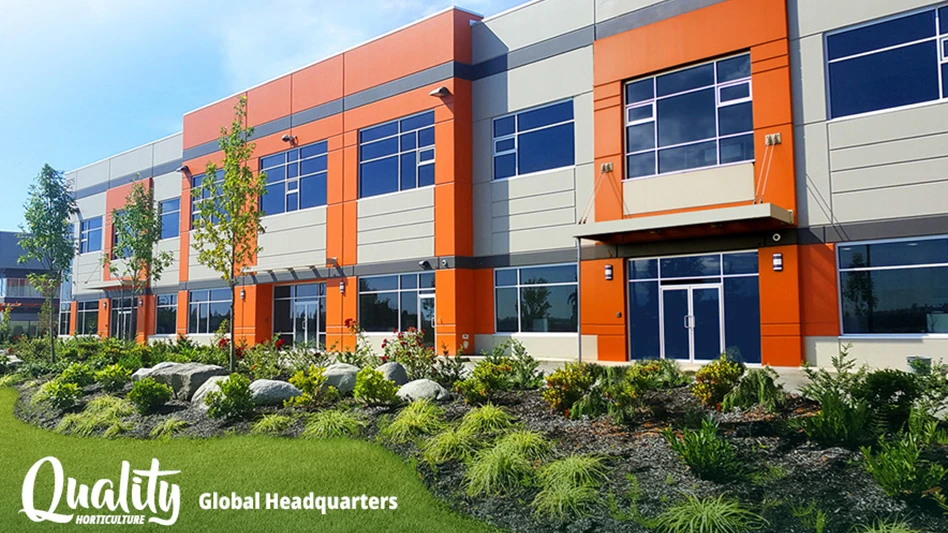 Mary Hausbeck Mary Hausbeck |
Bacterial diseases can ramp up on greenhouse tomato seedlings long before symptoms become obvious. Bacterial speck (Pseudomonas syringae pv. tomato), bacterial spot (Xanthomonas campestris pv. vesicatoria) and bacterial canker (Clavibacter michiganensis subsp. michiganensis) are three diseases that can wreak havoc in the greenhouse.
Symptoms of both bacterial speck and bacterial spot appear as dark blotches and/or spots on the leaves. Sometimes these blotches/spots are nearly black, but they can also be light brown. A yellow “halo” can surround these blotches/spots but may not always be present.
Bacterial canker looks different than other bacterial diseases. Canker causes a light browning along the leaf mid-veins and extends down the petiole. It is easy to overlook canker infection because it can mimic other disorders, including stress from drying. Bacterial canker symptoms do not appear to be “disease-like” compared to bacterial speck and spot.
Disease spread
In general, bacteria are spread via splashing water between plants and require a wound or a natural opening to gain entrance. A wound can be as small as a microscopic abrasion. Bacteria can move into a leaf via natural openings along the leaf edge. This can result in a dark fringing along the leaves’ outer edge.
Bacterial speck, bacterial spot and bacterial canker can be introduced to a tomato seedling via the seed. Bacteria can occur on the seed coat, but the bacterial canker bacteria can sometimes be inside the seed.
When the seed coat stays attached to the cotyledons following emergence, any bacteria on the seed coat can move to the seedling. They reproduce rapidly when conditions are warm and wet.
Bacteria move between plants by splashing water. Overhead watering allows bacteria to move readily from diseased transplants to adjacent healthy transplants. When the greenhouse humidity is especially high, the bacteria can become encapsulated within tiny airborne water droplets and may move within the greenhouse via water aerosols.
Bacteria can also be introduced to tomato seedlings via diseased plant residue left in the greenhouse. Old foliage may serve as a source of bacteria to infect a new group of seedlings.
Start control early
Bacterial control is best begun even before there is a sign of disease. Start with tomato seed that has been tested for bacterial pathogens and commercially treated. Growers can treat the seed themselves including using a hot water treatment. Although this treatment can be effective, the high temperature can hurt germination. Hot water treatment is not used widely but may be an option for those who are looking for relief from bacteria and are growing transplants for the organic industry and have limited options.
Keep the environment and foliage as dry as possible to limit the spread and development of bacterial diseases. Both conventional and organic growers can apply copper fungicide sprays to help limit diseases. Some bacterial pathogens may not respond to copper if they have mutated and developed resistance. Growers cannot immediately determine whether their particular bacterial problem responds to copper.
Based on research trials at Michigan State University, it is best to begin a copper spray program on tomato transplants as soon as the true leaves emerge and to re-apply the sprays every five days. To stay within label specifications of a seven-day application interval, copper-based products may need to be alternated. Streptomycin (i.e., AG Streptomycin and Agri-mycin 17) can also be used alone or in combination with copper products to limit bacterial disease on greenhouse tomato transplants. Check with state extension officials to ensure streptomycin is registered in your state. Tanos is labeled to suppress bacterial diseases.
Developing problems
Problems can develop as seedlings develop. Alternaria and Botrytis can cause problems as the seedlings grow and the lower leaves age, overlap and develop a canopy. Alternaria is also known as early blight and first appears on the oldest leaves mimicking a bulls-eye target with concentric rings in the spot/blotch. Botrytis is everywhere within the environment and is best known as grey mold because of its fuzzy grey spore masses that are produced on diseased leaves and stems. It is not uncommon for Botrytis to infect older tomato transplants via the cotyledons which are clinging to the stem. The pathogen then progresses into the stem and may constrict and girdle it.
Botrytis and Alternaria require the leaves stay wet for at least four to six hours so their spores can germinate and grow into the plant and cause disease. If the relative humidity is high during the day and the temperature drops even a degree or two, the moisture in the air can condense onto the foliage as a fine film and provide enough water for the spores to germinate and infect the plant.
Botytis is primarily a greenhouse problem but may also occur in low and high tunnels if there is inadequate ventilation and air movement. Once plants are moved outside, there is better air circulation and Botrytis becomes less of a problem.
Alternaria is a common problem in field production where it can overwinter in tomato plant debris. It can also occur on seedlings in the greenhouse.
Botrytis and Alternaria spores move on air currents within the greenhouse. Since they are common pathogens in the environment, the distance they might travel is not considered to be of great importance.
Reducing disease infection
Keeping the relative humidity lower than 85 percent and providing good air circulation limits disease. Water that accumulates under benches and tight plant spacing can contribute to pockets of high relative humidity that favors Alternaria and Botrytis.
Preventive fungicides are nearly always applied to prevent Botrytis and Alternaria since they can be frequent problems. There are several formulations of the fungicide Dithane available that can protect greenhouse seedlings. Heritage is also available and is especially effective against Alternaria and can be used in alternation with Dithane. Tanos can be used against Alternaria and can be alternated in a treatment program along with Dithane and/or Heritage to protect tomato seedlings. Decree is recommended when Botrytis control is needed.
Controlling late blight
Control measures for late blight include keeping the foliage dry, providing good air ventilation, spacing plants and heating when needed to dry out the greenhouse. Tomato transplant growers can protect against late blight with the same fungicides for Alternaria and Botrytis.
In Michigan State University tomato field trials, including 2009, the active ingredient in Dithane is excellent at protecting tomatoes from late blight. The active ingredient in Heritage (azoxystrobin) is also very good.
Revus (mandipropamid) is a new product, which received a supplemental label that included tomato in August 2009. It has been outstanding against late blight in our outdoor field trials. Revus can be used in the greenhouse on tomato seedlings, but it cannot be used on tomatoes for transplant production.
Revus does not control Alternaria or Botrytis, so it can be used in combination with a product that controls those pathogens. Revus can be rotated with other late blight fungicides including Curzate, Ranman and Tanos. Combining late blight fungicides with one of the Alternaria or Botrytis products can eliminate the potential occurrence of late blight when used preventively in the greenhouse.
Mary Hausbeck is professor at Michigan State University, Department of Plant Pathology, www.plantpathology.msu.edu.
|
 Mary Hausbeck
Mary Hausbeck





